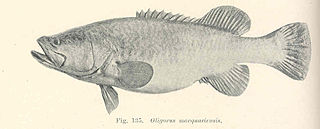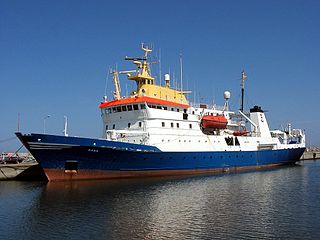Related Research Articles

The United States Fish and Wildlife Service is an agency within the United States Department of the Interior dedicated to the management of fish, wildlife, and natural habitats. The mission of the agency is "working with others to conserve, protect, and enhance fish, wildlife, plants and their habitats for the continuing benefit of the American people."

The trout cod or bluenose cod, is a large predatory freshwater fish of the genus Maccullochella and the family Percichthyidae, closely related to the Murray cod. It was originally widespread in the south-east corner of the Murray-Darling river system in Australia, but is now an endangered species.

Fisheries science is the academic discipline of managing and understanding fisheries. It is a multidisciplinary science, which draws on the disciplines of limnology, oceanography, freshwater biology, marine biology, meteorology, conservation, ecology, population dynamics, economics, statistics, decision analysis, management, and many others in an attempt to provide an integrated picture of fisheries. In some cases new disciplines have emerged, as in the case of bioeconomics and fisheries law. Because fisheries science is such an all-encompassing field, fisheries scientists often use methods from a broad array of academic disciplines. Over the most recent several decades, there have been declines in fish stocks (populations) in many regions along with increasing concern about the impact of intensive fishing on marine and freshwater biodiversity.

Hydrobiology is the science of life and life processes in water. Much of modern hydrobiology can be viewed as a sub-discipline of ecology but the sphere of hydrobiology includes taxonomy, economic and industrial biology, morphology, and physiology. The one distinguishing aspect is that all fields relate to aquatic organisms. Most work is related to limnology and can be divided into lotic system ecology and lentic system ecology.
IISD Experimental Lakes Area is an internationally unique research station encompassing 58 formerly pristine freshwater lakes in Kenora District, Ontario, Canada. In response to the International Joint Commission (IJC)'s 1965 recommendations related to transboundary pollution, the federal and provincial governments set aside these lakes to study water pollution. During the 1970s and 1980s, David Schindler, who was at that time 'Canada's leading ecologist', conducted a series of innovative, landmark large-scale experiments in ELA on eutrophication that led to the banning of phosphates in detergents. In an unexpected and controversial move that was widely condemned by the scientific community, in 2012 the ELA was de-funded by the Canadian Federal Government. The facility is now managed and operated by the International Institute for Sustainable Development (IISD) and has a mandate to investigate the aquatic effects of a wide variety of stresses on lakes and their catchments. IISD-ELA used the whole ecosystem approach and makes long-term, whole-lake investigations of freshwater focusing on eutrophication.

Steven J. Cooke is a Canadian biologist specializing in ecology and conservation physiology of fish. He is best known for his integrative work on fish physiology, behaviour, ecology, and human-dimensions to understand and solve complex environmental problems. He currently is a Canada Research Professor in Environmental Science and Biology at Carleton University and the Editor-in-Chief of the scientific journal Conservation Physiology.
Kenneth Radway Allen was a New Zealand fisheries biologist.
Robert Montgomery McDowall was one of New Zealand's most prominent freshwater ichthyologists.

Bronwyn May Gillanders is a marine scientist whose research spans freshwater, estuarine and marine waters while focusing on fish and fisheries ecology. Her studies of the Giant Australian cuttlefish of Northern Spencer Gulf in South Australia revealed the species' sensitivity to increases in salinity; a controversial aspect of the Environmental Impact Study (EIS) for the expansion of BHP Billiton's Olympic Dam mine. Gillanders' discovery was published in the scientific journal Marine Environmental Research and prompted environmental activists to call for the relocation of the project's proposed seawater desalination plant at Point Lowly, due to its proximity to the only mass breeding area for the animals' genetically distinct population. Gillanders commenced work at the University of Adelaide in 2001, received a tenurable position in 2007 and was appointed professor in 2010. She is the Director of the Marine Biology program at the university's Environment Institute.
The Fisheries Society of the British Isles is an international, non-political, learned society, based in the United Kingdom, that supports scientific activity in fish biology and management through charitable sponsorship. Membership is open to anyone interested in these objectives. There have been eleven Presidents of the FSBI since its foundation including Ray Beverton FRS and Felicity Huntingford FRSE.
Jack Vallentyne was a Canadian biochemist and the 2001 recipient of the A.C. Redfield Lifetime Achievement Award.

Peter B. Moyle is Distinguished Professor Emeritus in the Department of Wildlife, Fish and Conservation Biology and associate director of the Center for Watershed Sciences at the University of California, Davis. He has studied the ecology and conservation of fishes in freshwater and estuarine habitats in California (US) for over fifty years. He has a special interest in salmonid fishes and in the state's highly endemic freshwater and estuarine fish fauna. Moyle has authored or co-authored more than 270 peer-reviewed publications, including 10 books, and over 225 other publications, including ca. 75 blogs.
Emmeline Moore was an American biologist known for her various articles on fish diseases, as well as pioneering work in conservation and combating water pollution. She earned a PhD in biology from Cornell University in 1916. Moore supervised and edited fourteen watershed reports conducted in New York between 1926 and 1939 and these were the most comprehensive scientific surveys of any states' water resources. She died at a nursing home in Guilderland, New York at the age of 91 following an extended illness.

The Australian Society for Fish Biology (ASFB) is a professional organisation of fish and fisheries researchers. Founded in 1971, the society describes itself as a "professional, independent, non-profit, non-commercial and non-aligned organisation." The Australian Society for Fish Biology holds annual conferences for its members, sometimes in partnership with related organisations such as the Oceania Chondrichthyan Society and the Australian Society for Limnology. Former presidents of the society include Hamar Midgley (1977–79), Gerry Allen (1979–81), Julian Pepperell (1991–93) and Bronwyn Gillanders (2012–13).

Oscar Elton Sette, who preferred to be called Elton Sette, was an influential 20th-century American fisheries scientist. During a five-decade career with the United States Bureau of Fisheries, United States Fish and Wildlife Service and its Bureau of Commercial Fisheries, and the National Marine Fisheries Service, Sette pioneered the integration of fisheries science with the sciences of oceanography and meteorology to develop a complete understanding of the physical and biological characteristics of the ocean environment and the effects of those characteristics on fisheries and fluctuations in the abundance of fish. He is recognized both in the United States and internationally for many significant contributions he made to marine fisheries research and for his leadership in the maturation of fisheries science to encompass fisheries oceanography, defined as the "appraisal or exploitation of any kind of [marine] organism useful to Man" and "the study of oceanic processes affecting the abundance and availability of commercial fishes." Many fisheries scientists consider him to be the "father of modern fisheries science."
Gordon Pennington Gunter was an American marine biologist and fisheries scientist. He is noted for his pioneering study of fisheries in the northern Gulf of Mexico, a topic to which he devoted his entire professional life over a career spanning 60 years. His own research, and that of the scientists under his direction, established an understanding of the ecology, comparative physiology of the plant and animal life, and commercial fisheries of the region, and he coined the phrase "fertile fisheries crescent" to refer to Mississippi Sound and adjacent waters along the United States Gulf Coast. He also pioneered the study of the comparative physiology of shellfish and fish.
Sir Cyril Edward Lucas was a British marine biologist. He was Director of Fisheries Research in Scotland for 22 years. He was an expert on plankton and helped to develop the Continuous Plankton Recorder in 1931. He was also noted for his work on establishing fish stocks in the North Sea and was one of the first to suggest fish quotas to preserve stocks.
Nancy Marie Foster was the director of the National Ocean Service. She is known for her work in protecting marine environments, linking conservation groups and fisherman, and expanding research in marine environments.
Charles Remington Goldman is an American limnologist and ecologist.
Norman George Hall is an Australian fisheries scientist, known for his work on fisheries modelling and fisheries stock assessment. He received the K. Radway Allen Award in 2005 for his contributions to fisheries science.
References
- 1 2 3 "Fisheries Newsletter". Fisheries Newsletter. 22: 16. 1963 – via Google Books.
- 1 2 3 4 "50 years of history: Australian Society for Limnology" (PDF). Archived (PDF) from the original on 19 May 2021. Retrieved 20 May 2021.
- ↑ "Past ASFB Presidents". Australian Society for Fish Biology. Archived from the original on 28 February 2014. Retrieved 3 March 2017.